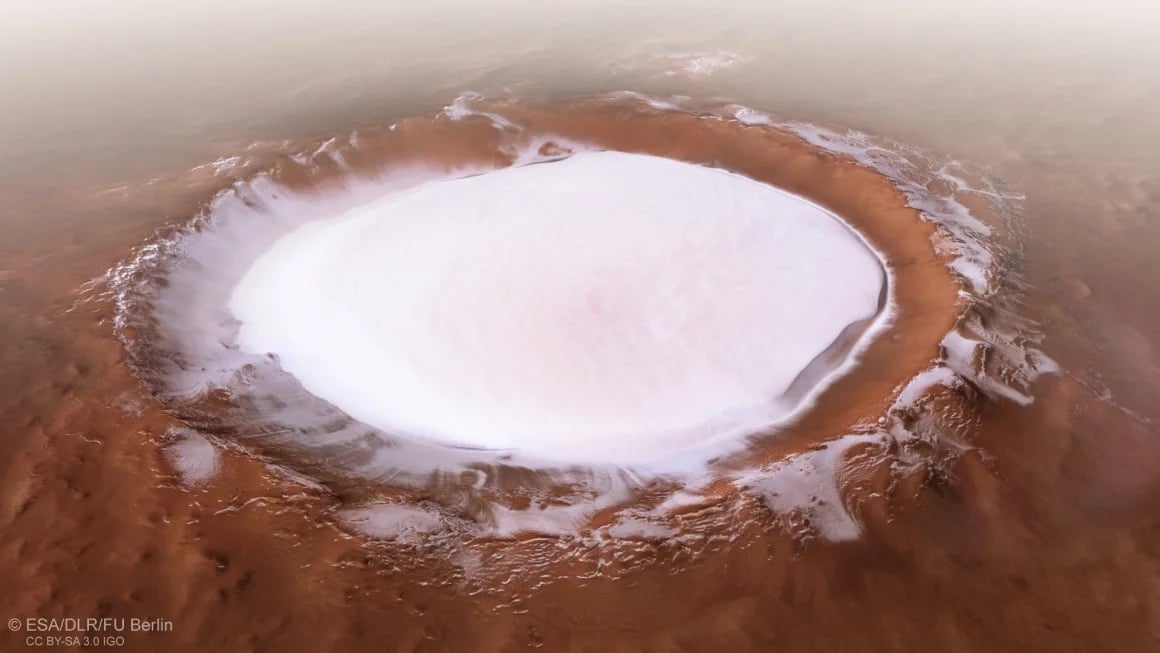Science
Ice Deposits in Martian Craters Reveal Planet’s Historic Climate Changes

Recent research led by a team from Okayama University has unveiled significant findings regarding the climatic history of Mars. The study, published in the journal Geology, reveals that ancient ice deposits found within Martian craters serve as a record of the planet’s climatic evolution over hundreds of millions of years. These ice layers indicate that Mars has undergone multiple ice ages, providing crucial insights into how the planet transitioned from a warm, wet environment to its current cold, arid state.
The research team, headed by Trishit Ruj, an associate professor at the Institute for Planetary Materials, investigated glacial landforms located between 20°N and 45°N latitude. They utilized high-resolution images captured by the Context Camera (CTX) and the High-Resolution Imaging Science Experiment (HiRISE) aboard NASA’s Mars Reconnaissance Orbiter (MRO) to analyze these topographical features.
Understanding Martian Climate History
The study revealed that these craters are characterized by unique features indicative of glaciation, such as ridges and debris formed by ice sheets. Researchers noted that ice deposits consistently accumulated in the shadowed southwestern walls of the craters. This pattern remained stable throughout various glacial periods during the Amazonian period, which spans from approximately 640 million to 98 million years ago.
Dr. Ruj emphasized that fluctuations in Mars’ axial tilt, or obliquity, drive the planet’s climate changes. He pointed out that, similar to Earth, these axial shifts influence the distribution of polar ice caps and mid-latitude glaciation. Unlike Earth, however, Mars experiences dramatic changes in its obliquity over extended periods, resulting in cycles of glaciation and thawing that gradually diminished its ice reserves.
The findings suggest that Mars has been steadily losing its water resources throughout the Amazonian Era, marking it as the latest and longest geological period in its history. The implications of this research extend beyond understanding Mars; they hold potential applications for future crewed missions that may rely on local water ice for sustaining human life, producing oxygen, and generating fuel.
Applications for Earth and Beyond
As exploration of Mars continues, the insights gathered from this research may guide future missions, particularly in terms of in-situ resource utilization (ISRU). Given that travel to Mars from Earth typically takes six to nine months, utilizing local resources will be essential for supporting human activities on the planet.
Additionally, the techniques developed to study Martian ice could also benefit environmental monitoring on Earth. As climate change accelerates the melting of ice caps and glaciers, the same imaging and modeling tools may assist scientists in tracking changes in Earth’s glaciers and permafrost, ultimately contributing to water resource management.
Dr. Hasegawa, a co-author from Kochi University, remarked on the broader significance of the study: “Mars serves as a natural laboratory for understanding how ice behaves over vast timescales. The insights we gain here can sharpen our understanding of climate processes on Earth as well.”
This ongoing research not only enhances our understanding of Mars’ history but also underscores the interconnectedness of planetary science and climate change, providing valuable lessons for both Martian explorers and those of us living on Earth.
-

 Sports1 week ago
Sports1 week agoSteve Kerr Supports Jonathan Kuminga After Ejection in Preseason Game
-

 Politics1 week ago
Politics1 week agoDallin H. Oaks Assumes Leadership of Latter-day Saints Church
-

 Lifestyle1 week ago
Lifestyle1 week agoDua Lipa Celebrates Passing GCSE Spanish During World Tour
-

 Business1 week ago
Business1 week agoTyler Technologies Set to Reveal Q3 2025 Earnings on October 22
-

 World1 week ago
World1 week agoD’Angelo, Iconic R&B Singer, Dies at 51 After Cancer Battle
-

 Lifestyle1 week ago
Lifestyle1 week agoKelsea Ballerini Launches ‘Burn the Baggage’ Candle with Ranger Station
-

 Entertainment1 week ago
Entertainment1 week agoZoe Saldana Advocates for James Cameron’s Avatar Documentary
-

 Science1 week ago
Science1 week agoChicago’s Viral ‘Rat Hole’ Likely Created by Squirrel, Study Reveals
-

 Health1 week ago
Health1 week agoRichard Feldman Urges Ban on Menthol in Cigarettes and Vapes
-

 Health1 week ago
Health1 week agoCommunity Unites for Seventh Annual Mental Health Awareness Walk
-

 Business1 week ago
Business1 week agoMega Millions Jackpot Reaches $600 Million Ahead of Drawings
-

 Business1 week ago
Business1 week agoMLB Qualifying Offer Jumps to $22.02 Million for 2024









